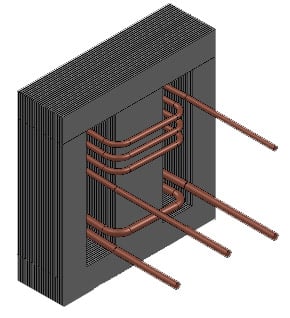Transformers are an essential part of many electrical systems. They are used to transmit power, distribute power, and convert voltages. By understanding the relationship between transformer core size and ampere output, you can select the right transformer for your application.
Also Read: Step down Transformer Working
A transformer transfers energy from one electrical circuit to another without the use of moving parts. It is based on the principle of electromagnetic induction.
The transformer has two coils of wire, the primary coil and the secondary coil. The primary coil is connected to the input voltage source and the secondary coil is connected to the output load.
When an alternating current (AC) is applied to the primary coil, it creates a magnetic field. This magnetic field passes through the secondary coil and induces an AC voltage in the secondary coil. The voltage induced in the secondary coil is proportional to the number of turns in the secondary coil divided by the number of turns in the primary coil.

Does Transformer Core Size Matter?
The transformer core is made of a ferromagnetic material, such as iron or steel. The core’s purpose is to concentrate the magnetic field so that it is more effective in inducing a voltage in the secondary coil. The core size is determined by the amount of current that the transformer will be carrying. The larger the core, the more current it can carry without saturating.
The current output of a transformer is determined by the cross-sectional area of the core, the frequency of the input voltage, and the number of turns in the secondary coil. The cross-sectional area of the core determines the amount of magnetic flux that can be produced.
The frequency of the input voltage determines the number of times per second that the magnetic field changes direction. The number of turns in the secondary coil determines the amount of voltage that is induced in the secondary coil.
The following formula can be used to calculate the ampere output of a transformer:
Amperage = (Cross-sectional area of core)×(Frequency of input voltage)×(Number of turns in secondary coil)
The transformer core size and the ampere output are directly related. The larger the core, the more current the transformer can carry. The smaller the core, the less current the transformer can carry.
It is important to select a transformer with a core size that is large enough to handle the current that the transformer will be carrying. If the core is too small, the transformer will overheat and could be damaged.
Here are some additional factors to consider when selecting a transformer:
Voltage: The transformer must be able to handle the input voltage and the output voltage.
Frequency: The transformer must be designed for the frequency of the input voltage.
Insulation: The transformer must be insulated to prevent electrical shock.
Cooling: The transformer must be able to dissipate heat without overheating.
FAQs
Q: What is the purpose of a transformer in electrical systems?
Transformers are essential for transmitting power, distributing power, and converting voltages in electrical systems.
Q. Does the size of the transformer core matter?
Yes, the size of the transformer core is crucial. It determines the amount of current the transformer can carry without saturating. A larger core allows for the handling of more current, while a smaller core has limitations.
Q. Why is it important to select the right core size for a transformer?
Selecting the appropriate core size ensures that the transformer can handle the current it will carry without overheating or sustaining damage. Using a core that is too small for the required current can lead to performance issues and potential transformer failure.
Q. What happens if a transformer core is too small for the required current?
If the transformer core is too small for the necessary current, the transformer may overheat, potentially leading to malfunctions, reduced efficiency, and even damage to the transformer.








